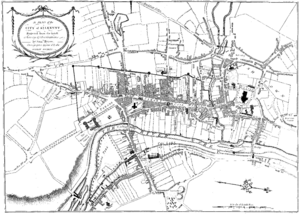Irishtown, Kilkenny facts for kids
Irishtown (Irish: An Baile Gaelach) is a historic neighborhood in Kilkenny, Ireland. It is located around the famous St Canice's Cathedral. Long ago, Irishtown was a separate town, also known as Newcourt or St Canice's. It was divided from the main walled town of Kilkenny by the Breagagh River.
Contents
A Look Back at Irishtown's History
Irishtown has a very old history! It was once the main place for the Mac Giolla Phádraig dynasty, who ruled the medieval Kingdom of Ossory. A special church, linked to Aghaboe Abbey, was built there.
How Irishtown Became Important
In 1111, a big meeting called the Synod of Ráth Breasail decided how Ireland would be divided into church areas, called dioceses. The Diocese of Ossory was created, and the church in Irishtown became St Canice's Cathedral. The name Kilkenny actually comes from the Irish words Cill Chainnigh, which means "church of St. Canice". Because the cathedral was there, the area grew and became more important.
English Town and Irish Town
After the Norman invasion of Ireland, new rulers, the Anglo-Normans, built Kilkenny Castle nearby. This castle became the main place for the new County Kilkenny. Two separate towns were recognized:
- The "English Town" or "High Town" was for the new settlers, built around the Castle.
- The "Irish Town" was for the native Gaelic people, built around the Cathedral.
These two towns were both walled towns with their own walls. They were connected by Watergate Bridge over the Breagagh River. Irishtown was generally not as wealthy as the English Town. The people who ran Irishtown were mostly church officials.
Changes Over Time
In 1609, Kilkenny became a city. A special area called the "County of the City" was created, separate from County Kilkenny. This new area included Irishtown.
A very important event happened in 1650. Oliver Cromwell's army entered Irishtown through Dean's Gate. From there, they went on to capture Kilkenny, which was then the capital of Confederate Ireland.
Political Changes
For a long time, Irishtown had its own representatives in the Irish Parliament. This area was called the St Canice constituency. It was separate from the Kilkenny City constituency. The Bishop of Ossory had a lot of say in who represented St Canice.
However, things changed in 1800 with the Acts of Union 1800. Irishtown lost its right to send its own representatives to Parliament. Its local government, called the corporation, stayed separate from Kilkenny's until 1840.
In 1840, a new law called the Municipal Corporations (Ireland) Act 1840 changed everything. Both the Irishtown and Kilkenny corporations were ended. The people who managed Kilkenny, called town commissioners, took over both areas. This law officially made Irishtown part of the larger Kilkenny borough. The old records from Irishtown's corporation were moved to the Kilkenny Tholsel.
In 1846, a book called the Parliamentary Gazetteer described how Irishtown and Kilkenny had become one: "The city is divided by the Bregah rivulet into the two big parts of Irishtown and Englishtown... Even though they used to be seen as separate towns, with their own rules and governments, they are now completely joined together. You wouldn't know they were ever separate, except that each still has parts of its original look. Irishtown has St. Canice cathedral on a hill in the north, and Englishtown has Kilkenny-castle on a hill in the south-east."
Irishtown Today
Even though it's now part of the bigger city, the historic Irishtown area still feels special. The main street leading south from the Cathedral to the Breagagh River is still called Irishtown.


